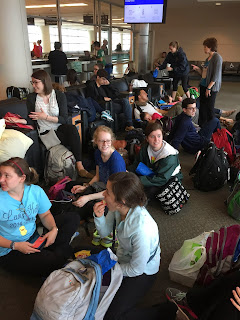Once the choir got over the crazy, surrealistic feeling of actually being in this beautiful harbor city, we rolled up our sleeves and got to work: we had a dynamic parish in North Sydney that graciously hosted us for five days; we were shuttling back and forth from the nearby suburban diocese of Parramatta; we were there for the Solemnity of Trinity Sunday (which meant a whole new repertoire, a cathedral vigil mass, and two Sunday liturgies). There was a whole lot of music going on.
Throughout this period of intense labor, I was transfixed, in awe, of the energy brought by our students to the parishes and workshops of Australia. Here were a bunch of young people who had traveled across fourteen time zones. They were moving in and out of various roles: as tourists and ambassadors and singers and clinicians, going home to host families every night (along with the requisite social demands there as well). But all I saw was poise, spot-on singing and playing, and good will.
Once again, our students led the charge in the midst of a huge diocesan gathering – this one for secondary students. The young men and women arrived, and they were tight-lipped: no sense of faith sharing, no singing along, only a tremendous sense of peer pressure – pressure to keep a lid on anything having to do with spirituality.
When we constructed our diocesan days, we knew full well that the best tonic for these younger students were the college students in the Folk Choir. Aussie kids would be interested in the American accents, and most of all, high school kids worship their collegiate counterparts. So we let our singers and musicians loose, let them lead, let them teach, let them exude the joy and enthusiasm which is so uniquely that which they bring to their expression of Church.
Both in Melbourne and now, again in Sydney, we let our student ambassadors and singers do what they do best – unleash the power of their song, give permission to be spiritual, encourage the voices and hearts of those around them. One after another – Melbourne, Ballarat, and now Sydney, North Sydney, and Parramatta – each one now has the stamp of the Folk Choir left upon it.
Throughout this period of intense labor, I was transfixed, in awe, of the energy brought by our students to the parishes and workshops of Australia. Here were a bunch of young people who had traveled across fourteen time zones. They were moving in and out of various roles: as tourists and ambassadors and singers and clinicians, going home to host families every night (along with the requisite social demands there as well). But all I saw was poise, spot-on singing and playing, and good will.
Once again, our students led the charge in the midst of a huge diocesan gathering – this one for secondary students. The young men and women arrived, and they were tight-lipped: no sense of faith sharing, no singing along, only a tremendous sense of peer pressure – pressure to keep a lid on anything having to do with spirituality.
When we constructed our diocesan days, we knew full well that the best tonic for these younger students were the college students in the Folk Choir. Aussie kids would be interested in the American accents, and most of all, high school kids worship their collegiate counterparts. So we let our singers and musicians loose, let them lead, let them teach, let them exude the joy and enthusiasm which is so uniquely that which they bring to their expression of Church.
Both in Melbourne and now, again in Sydney, we let our student ambassadors and singers do what they do best – unleash the power of their song, give permission to be spiritual, encourage the voices and hearts of those around them. One after another – Melbourne, Ballarat, and now Sydney, North Sydney, and Parramatta – each one now has the stamp of the Folk Choir left upon it.

























